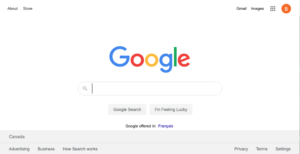What Are Keywords?
Have you ever googled a subject and wondered what determines the content that comes up in your google search? Or maybe you’ve wondered why some articles appear at the front of your search while others show further down the page. If you are trying to create a strong presence online, you’ll want to know the answer to these questions. In short, it largely relates back to one thing: keywords!
 The term “keywords” (also known as “SEO words” or “search terms”) refers to the words or phrases people enter into a search engine like Google, Bing or others, when seeking to locate information on a particular topic. Beyond individual words, “keywords” can also refer to phrases related to the concepts being communicated in a piece of writing or a larger body of work, like a website. How well those keywords are implemented will directly determine which pages or websites come up in a Google search and which ones rank further up the page than others do. That’s why it’s important that you choose and use keywords strategically if you want to rank high on the SERP (search engine results page).
The term “keywords” (also known as “SEO words” or “search terms”) refers to the words or phrases people enter into a search engine like Google, Bing or others, when seeking to locate information on a particular topic. Beyond individual words, “keywords” can also refer to phrases related to the concepts being communicated in a piece of writing or a larger body of work, like a website. How well those keywords are implemented will directly determine which pages or websites come up in a Google search and which ones rank further up the page than others do. That’s why it’s important that you choose and use keywords strategically if you want to rank high on the SERP (search engine results page).
The goal is to use keywords that will communicate the subject clearly and thoroughly in a way that will relate back to the searches people do for websites in your field. How well you use keywords is a primary factor in whether you will succeed in having a lot of visitors to your site as well as follow up.
How Do Search Engines Decide How To Rank Pages?
The process of using keywords relates back to what is known as SEO or search engine optimization. Keywords are one of primary aspects of SEO in helping you generate as much traffic as possible to your page. In order to better understand keywords as they relate to SEO, let’s take a look at how the Google ranking system works.
According to Google, its “ranking systems are made up of not one, but a whole series of algorithms. To give you the most useful information, search algorithms look at many factors, including the words of your query, relevance and usability of pages, expertise of sources, and your location and settings.”
 An algorithm serves the purpose of receiving input and then follows a specific process, such as a set of rules or patterns in order to determine and calculate the output. In other words an algorithm is simply another word for a function that follows a particular predetermined pattern to process data and yield a precise output. In this case, the input or data are the keywords and phrases people use in a Google search, and the function is sorting through those keywords to provide output in the form of websites according to rank.
An algorithm serves the purpose of receiving input and then follows a specific process, such as a set of rules or patterns in order to determine and calculate the output. In other words an algorithm is simply another word for a function that follows a particular predetermined pattern to process data and yield a precise output. In this case, the input or data are the keywords and phrases people use in a Google search, and the function is sorting through those keywords to provide output in the form of websites according to rank.
Previously, the only tool Google and other search engines used to determine the content and relevance of a page were keywords that occurred repeatedly throughout the text of a page. That meant two primary things: unless those words were used several times, Google was not equipped to determine what that page was about. As well, the more times a keyword was used, the higher up that page or website would rank, which would naturally generate more traffic to that particular website.
This became problematic because some pages were contributing poor content, and still coming up on top of the search engine result page (SERP), simply by stuffing into their material as many keywords as possible. It was an easy way to get a strong presence on the web without much work, but it was obviously bringing the overall quality of online content down.
This issue was addressed by Google through implementing additional algorithms that scan for quality content as well as determining more precisely what a person is searching for.
Three of Google’s primary algorithms are:
- Panda
- Penguin
- Hummingbird
Although Google’s search engine still ranks for keywords, like those that are used in the title and interspersed throughout the text, these additional algorithms allow it to address the issue of misuse (overuse and unnatural use) of keywords in a text. The Panda algorithm addresses the issue of low quality and repetitive text. “Penguin” addresses the unnatural use of keywords, so that stuffing as many keywords as possible onto a page no longer causes it to rank high. The Hummingbird algorithm helps determine the search intent of a query and the overall meaning of words as opposed to just the words themselves.
Types of Keywords
With all these changes being implemented by Google, the area of  keywords in SEO has expanded significantly. In light of these changes, you are now not only going to want to have recurring “target words” (the words that directly describe the core of your intent, usually found in your title) but you need to know what key phrases (another form of keywords) will cause your page to rank high. You’ll also want to discover those words that will indirectly get your page more traffic. These things are addressed through a few different categories of keywords:
keywords in SEO has expanded significantly. In light of these changes, you are now not only going to want to have recurring “target words” (the words that directly describe the core of your intent, usually found in your title) but you need to know what key phrases (another form of keywords) will cause your page to rank high. You’ll also want to discover those words that will indirectly get your page more traffic. These things are addressed through a few different categories of keywords:
- Target keywords
- Medium and Longtail keywords
- LSI keywords
Target Keywords
We’ve already touched upon target keywords (also referred to as “fatheads”). These are the words that best describe or communicate your subject directly to your reader and are used to summarize your page. They are also known as “shorttail” keywords and are generally three words or less and are often based on the words found in the title of your particular page or article and website. For example, if your page or website is “Gardening in Desert Climates,” your target keyword would be “gardening.”
 When choosing your target keywords, you’ll be aiming for the words or phrases you anticipate will be typed in by people doing a search for what your page is about. Your goal in using target keywords is to insert them in your text as naturally as possible. There is no set rule as to how many times you can use a keyword or not, but generally speaking one keyword for every two hundred words has been suggested as acceptable by some. Remember, unnatural use or overuse of keywords may be interpreted as a sign of poor content by Google’s search engine. Used correctly, however, they are going to help you rank higher on the SERP, and consequently, attract more visitors.
When choosing your target keywords, you’ll be aiming for the words or phrases you anticipate will be typed in by people doing a search for what your page is about. Your goal in using target keywords is to insert them in your text as naturally as possible. There is no set rule as to how many times you can use a keyword or not, but generally speaking one keyword for every two hundred words has been suggested as acceptable by some. Remember, unnatural use or overuse of keywords may be interpreted as a sign of poor content by Google’s search engine. Used correctly, however, they are going to help you rank higher on the SERP, and consequently, attract more visitors.
Your shorttail keywords will usually have a good return for search volume. That means these are words are popular in searches because a lot of people type them in. However, with the greater popularity of a word comes greater competition. So while these words are a good place to start, you can optimize them by using them alongside medium and longtail keywords.
Medium and Longtail Keywords
Medium keywords are generally 3 word phrases where as “longtails” are keywords in the forms of phrases that utilize three or more words in a row. They are generally an expanded form of your target keyword(s) that relate directly back to your core product or theme, often utilizing words found in the title of the page. Due to the aspect of being able to incorporate more words, you can be more specific about your subject matter. That means that while they may not rank as high for search volume, you’ll have a better yield for product because they’ll help you write content that better clarifies your page to bring in your target audience. When you draw in a more targeted audience you’re reaching the types of consumers most likely to follow up with you further on your product or service.
Another aspect of longtails is they commonly include words like “best, top, how, why, what.” These words quantify what a searcher is looking for. This allows the search engine to better determine the user’s search intent in order to pull up the best matches for their queries, which makes them great to include in your text.
Examples of a Longtail Keywords
Consider the following example: Suppose your main keyword is “piano” because you have a store that sells refurbished pianos. Although the word “piano” will have a high search volume, not everyone who types in “piano” is looking to buy a piano, or one that’s second hand. Some may be looking for “piano lessons,” or “piano sheet music” or a bran new piano. But if you include some clarifying phrases, such as “antique used pianos for sale” or “top quality refurbished piano store,” your page is suddenly more user specific and will yield a higher conversion rate. In other words, although you will have a lower search volume (less clicks on your link) for a more specific keyword entry, the people that do click will be a more targeted audience. That means they will be more likely to actually read your page and follow up for a purchase because they’ve found more precisely what they were searching for. In the end, that gives you a higher conversion rate per search and that’s what you want.
Let’s look at one other example that shows how we can use medium and long keywords to capitalize on user intent to bring in traffic.
User Specific Long and Medium Keywords
 Say you’re selling used cars, and your business is called “Dave’s Used Cars.” The word “cars” is going to rank really high for search volume. However, people may be looking for “classic cars” or “toy cars” and so on. So the word “cars” will get you a lot of traffic, but with a lower conversion rate. That’s not to say you shouldn’t use “cars” or better yet “used cars” as a keyword, it just points to the need to be more user specific. For example, perhaps Dave has a preference for Ford motor vehicles over others. In that case, a more user specific search would be “Used Ford Cars.” He will still rank for the word “cars,” but he’ll be more likely to make a sale because he’s pinpointed his target audience: people looking for the brand “Ford.” At this point, Dave has created a much more user specific keyword.
Say you’re selling used cars, and your business is called “Dave’s Used Cars.” The word “cars” is going to rank really high for search volume. However, people may be looking for “classic cars” or “toy cars” and so on. So the word “cars” will get you a lot of traffic, but with a lower conversion rate. That’s not to say you shouldn’t use “cars” or better yet “used cars” as a keyword, it just points to the need to be more user specific. For example, perhaps Dave has a preference for Ford motor vehicles over others. In that case, a more user specific search would be “Used Ford Cars.” He will still rank for the word “cars,” but he’ll be more likely to make a sale because he’s pinpointed his target audience: people looking for the brand “Ford.” At this point, Dave has created a much more user specific keyword.
But Dave can take it one step further. He can then list the actual models he sells, doing medium or longtail keywords based on that. For example, “Used Ford Sierra” would work as a medium keyword, or he could expand it to a longtail keyword, with something like “Best Priced Used Ford Sierras.” Again, there will be a lot less people looking for “Sierras,” then there will be “used cars.” But by going this route, he’s narrowed down his audience to get a higher conversion rate per click. Generally speaking, those who know they want a Sierra will likely be more apt to click on his page, verses another page that simply lists used cars. And for any searches done for “Sierras,” Dave’s page will have a greater chance of ranking higher in the search engine than generic competitors. That’s the beauty of targeting user intent through the additional use of medium and longtail keywords.
LSI Keywords
Another style of keywords you’ll want to employ are “LSI” words, short for “Latent Semantic Indexing.” While LSI keywords are directly related to your target keyword(s), they provide a broader picture by touching on subtopics within the context of your main theme. To apply them, you’ll want to use words or even short phrases that relate back to the main topic through association, but LSI words are not synonyms. For example, if your keyword is love, and you type in a synonym such as “adoration,” it won’t qualify because it’s just another word for love. But if you type in a word related to love such as “marriage” or “dating,” you’ll have just supported your main topic with associated subtopics, which is what LSI is about.
Let’s look at another example of how all this fits together. Suppose you have a website for a business called “Modern Cooking Classes.” A possible longtail keyword might be “Cooking Classes for Seniors” or “Best Cooking Classes For Beginners,” or whatever specifics are a part of your business.
Some possible LSI words that relate to the example may include words like: “Modern Cooking Classes” “recipes,” “ingredients,” “chef,” and so on.
These possible examples are suggestive of your main topic in a broader sense than your other keywords, addressing different subtopics and side characteristics. This is what will help the search engine determine whether you are covering your topic well, with quality content, as well as the relevance or your page. These are all things that will directly factor into you getting a better ranking.
What’s really exceptional is that you can use as many LSI words as you want without being penalized (which, as noted previously, can happen if you use your target keywords too many times). But just make sure that they fit naturally into the flow of your text, so that they add quality, rather than stuffing them in unnaturally.
Keep It Varied
With the different types of keywords available, you’ve got several options to use to help you rank higher in Google and other search engines. Each form will bring you traffic, and you’re wise not to choose one above the other, but to have a mix of each kind on your page. As well, keep in mind that what Google is going to rank is your pages and not the website as a whole. So using each page as an opportunity to include different keywords, rather than just repeating the same ones on each will potentially open the door to a greater number of varied search queries.
Applying Your Keywords
Now that you know what keywords are and how they work, your  next step is going to be to determine exactly which keywords are best related to your niche and some guidelines for applying them in your text. This is called “keyword analysis.” It involves several steps and is pivotal to getting you the kind of rank score you want for your page or website. You can read more about Keyword Research and Analysis here.
next step is going to be to determine exactly which keywords are best related to your niche and some guidelines for applying them in your text. This is called “keyword analysis.” It involves several steps and is pivotal to getting you the kind of rank score you want for your page or website. You can read more about Keyword Research and Analysis here.
At Pathways, we have a team that is qualified in using keyword analysis tools and structuring your pages so that you’ll rank well in any search engine results. Please feel free to contact us if you’d like our help in making keywords work for you. We’d love to help you build a strategic online presence that will help you reach your goals.

